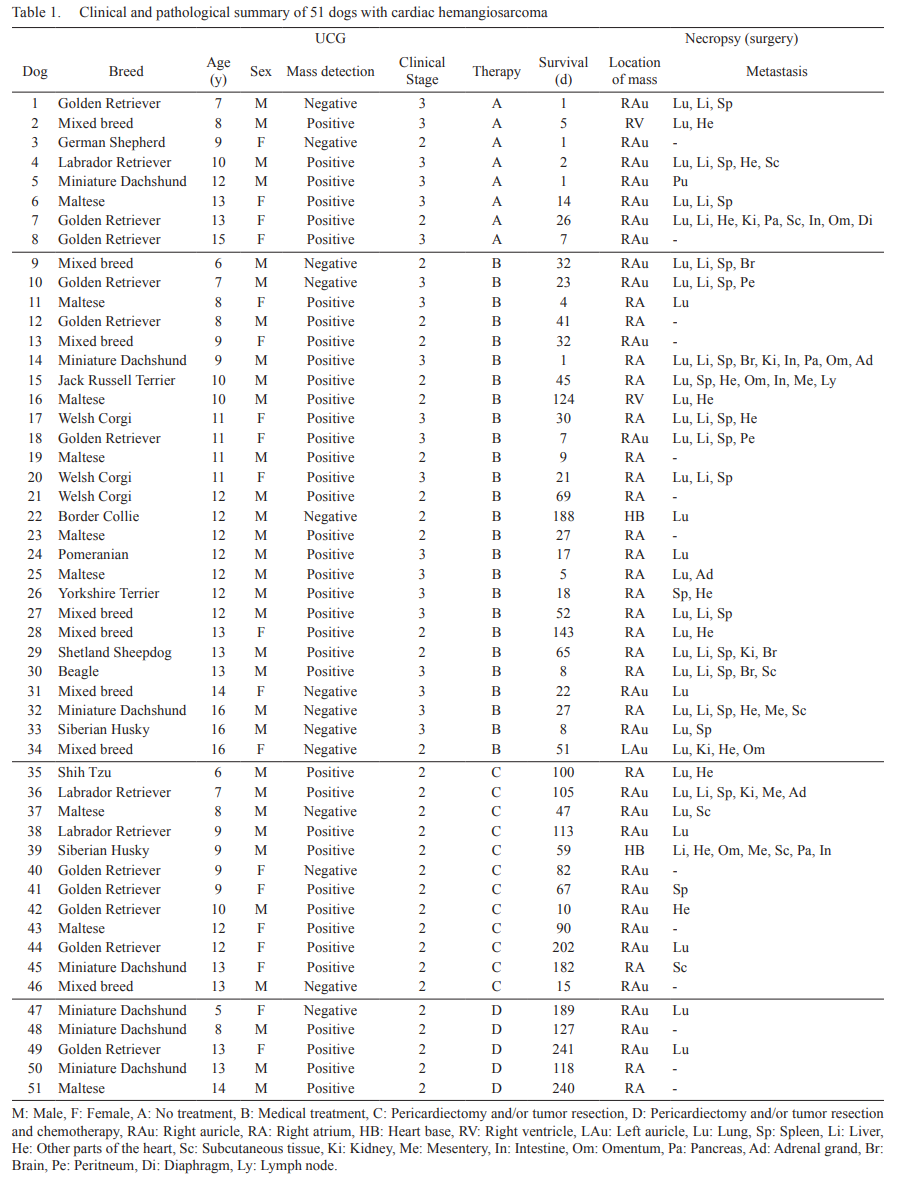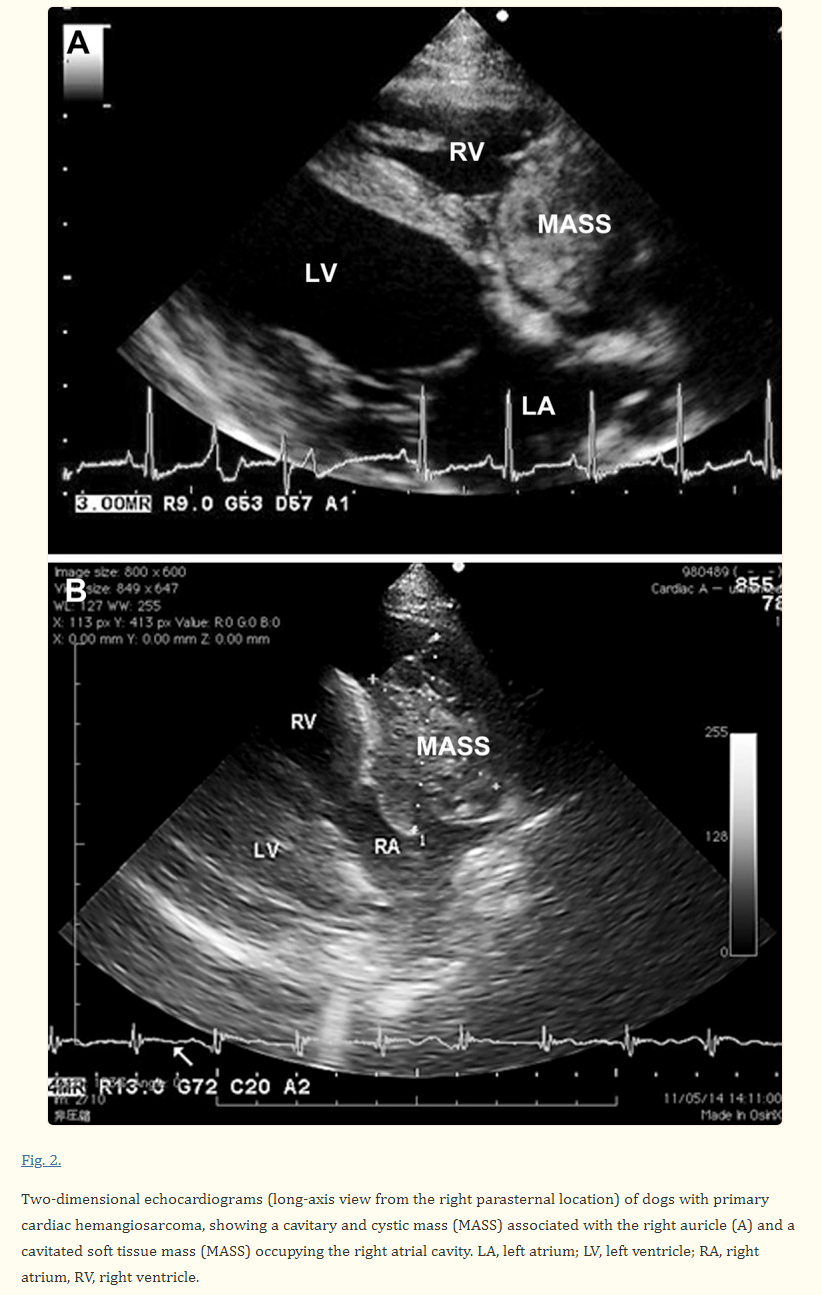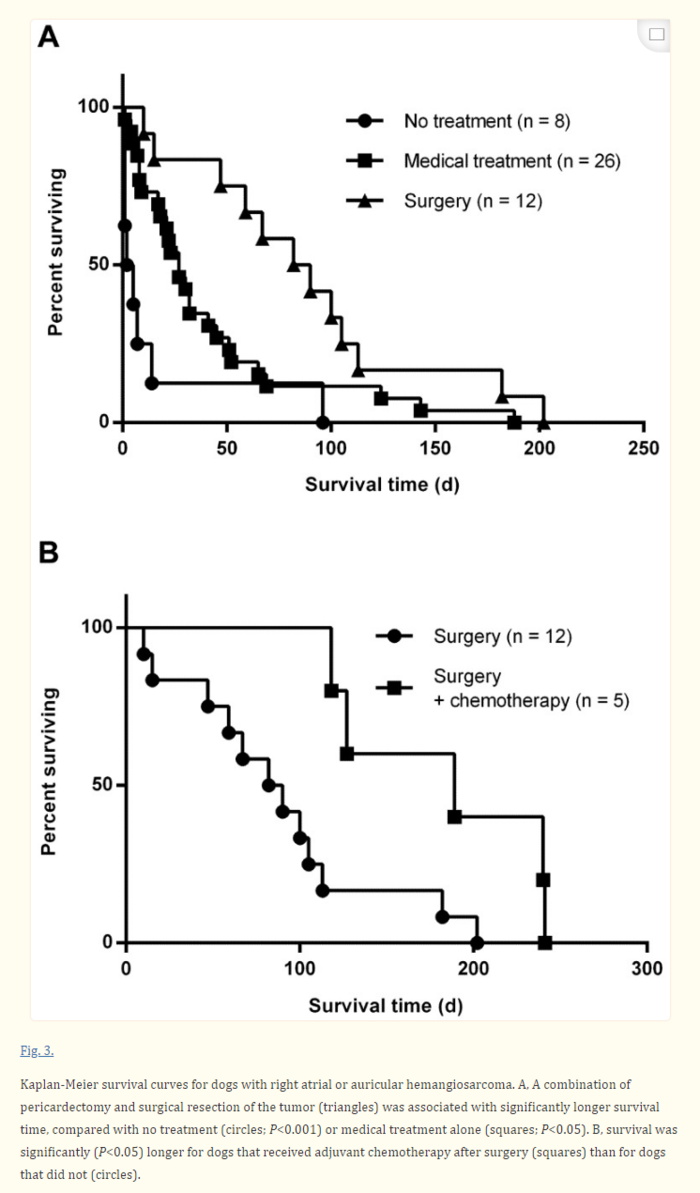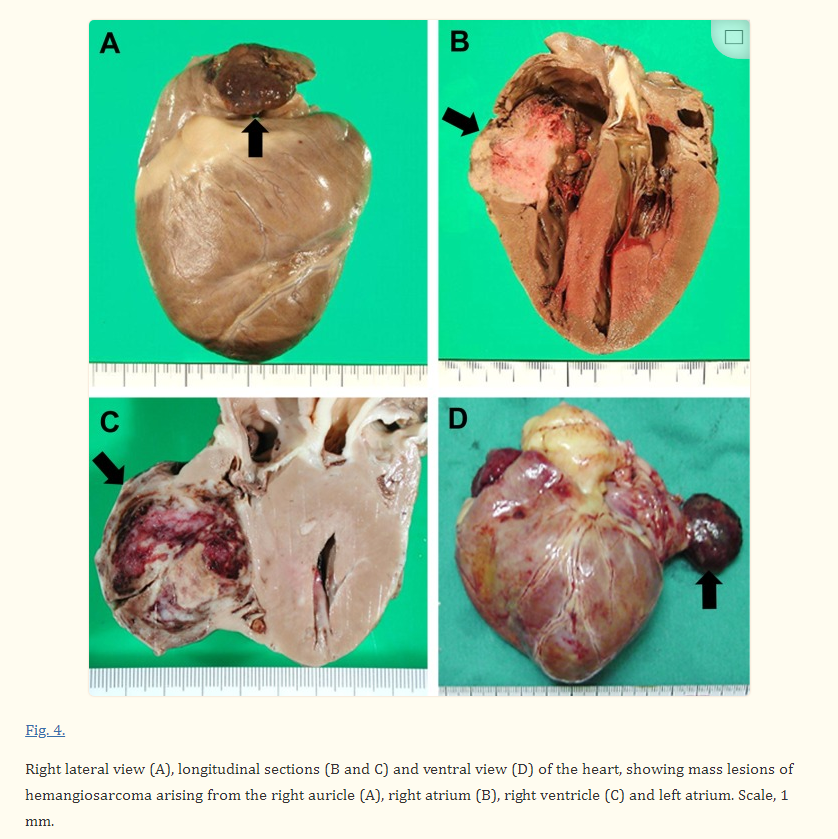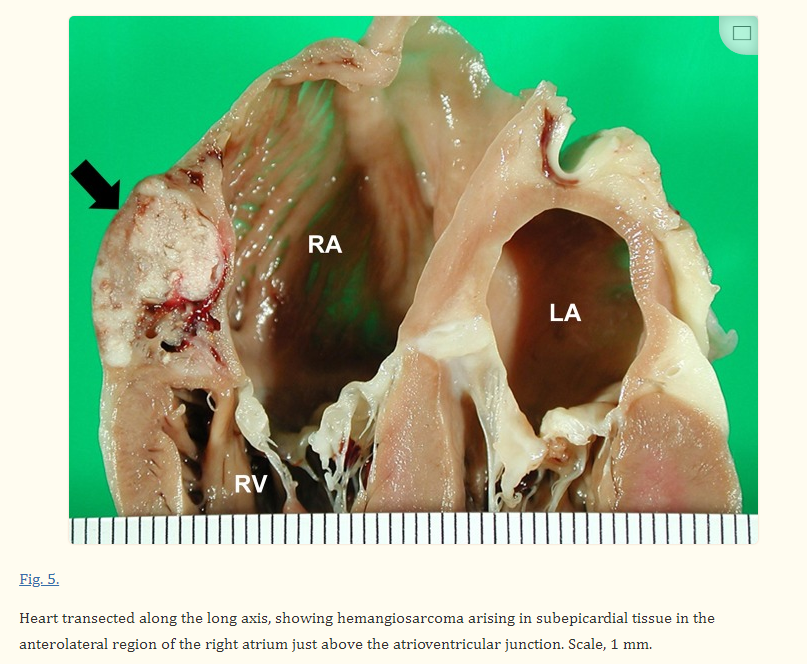狗狗原发性心脏血管肉瘤的流行病学、临床和病理特征:51例的回顾
(→概述) |
|||
| 第1行: | 第1行: | ||
原文:https://pubmed.ncbi.nlm.nih.gov/23811814/ | 原文:https://pubmed.ncbi.nlm.nih.gov/23811814/ | ||
| + | |||
| + | Published: 2013 Nov | ||
== 摘要 (Abstract) == | == 摘要 (Abstract) == | ||
2024年6月26日 (三) 17:37的版本
原文:https://pubmed.ncbi.nlm.nih.gov/23811814/
Published: 2013 Nov
目录 |
1 摘要 (Abstract)
在此介绍的研究中,我们旨在描述 51 例经组织学证实诊断为原发性心脏血管肉瘤 (HSA) 的犬类病例的流行病学、临床和病理学发现。检查每只狗的医疗数据,包括信号、主诉、体格检查结果、各种诊断测试的结果和治疗方法。此外,对所有51例病例进行了病理复查。肿瘤最常发生在年长的金毛猎犬中,其次是马耳他犬和微型腊肠犬。HSA的占位性病变更常见于右耳廓(RAu)(25/51)和右心房(RA)(21/51),RA肿块明显大于RAu肿块(P<0.001)。RAu组肿块的超声心动图检出率(60%;15/25)明显低于RA组(95%;20/21)。5只在肿瘤切除后接受辅助化疗的狗的生存时间(P<0.05)明显长于12只未接受辅助化疗的狗。在这个系列中,马耳他犬 (9/51) 和微型腊肠犬 (7/51) 以及金毛猎犬比其他品种更频繁地出现。与RA肿块相比,RAu肿块的超声心动图检出率较低,这可能与肿瘤大小和/或位置有关。接受辅助化疗的狗的生存时间明显更长,这表明术后化疗可能对患有心脏 HSA 的狗有用。
In the study presented here, we aimed to describe the epidemiological, clinical and pathological findings of 51 canine cases with histologically-verified diagnoses of primary cardiac hemangiosarcoma (HSA). The medical data for each dog, including signalment, presenting complaints, physical examination findings, results of various diagnostic testing performed and method of treatment, were checked. In addition, all 51 cases were re-examined pathologically. The tumor occurred most frequently in older Golden Retrievers, followed by Maltese dogs and Miniature Dachshunds. Mass lesions of HSA were found more commonly in the right auricle (RAu) (25/51) and right atrium (RA) (21/51), and the RA masses were significantly (P<0.001) larger than the RAu masses. The echocardiographic detection rate of masses in the RAu group (60%; 15/25) was significantly lower than that in the RA group (95%; 20/21). Survival time was significantly (P<0.05) longer for 5 dogs that received adjuvant chemotherapy after tumor resection than for 12 dogs that did not. In this series, the Maltese (9/51) and Miniature Dachshund (7/51), as well as the Golden Retriever, were represented more frequently than other breeds. The lower echocardiographic detection rate of RAu masses compared with RA masses may be related to tumor size and/or location. The significantly longer survival time for dogs receiving adjuvant chemotherapy indicates that postoperative chemotherapy could be useful for dogs with cardiac HSA.
2 概述
血管肉瘤(hemmangiosarcoma, HSA)是一种侵袭性恶性肿瘤,起源于血管内皮细胞或内皮前体细胞[20]。原发性HSA可发生于身体任何血管化部位,但最常见的起因部位包括脾脏、右心房和耳廓、皮下组织和肝脏[4,8,14,33]。这种肿瘤很容易通过血源性途径转移到远处器官,因为它很容易进入体循环,肺部是最常受累的部位[23,29]。
根据一项数据库调查,累及心脏的肿瘤在狗中很少发生,总发病率为 0.19%[32]。HSA 是累及犬类的最常见心脏肿瘤类型,占根据组织学类型确定的所有心脏肿瘤的 69% [32]。其发病率比第二常见的心脏肿瘤主动脉体肿瘤高约 10 倍[32]。德国牧羊犬(German Shepherd Dogs, GSs)和金毛猎犬(Golden Retrievers, GRs)的心脏HSA发生率似乎更高[1,2,4,15,19,24,27,30],没有明显的性别偏好[1,30]。大多数病例中,原发性 HSA 位于右心房(RA)或耳廓(RAu)[1,2,13,19,24],但偶尔肿瘤可能出现在左侧心腔[1,11,19]。
心脏 HSA 的首发体征通常与心包积液(pericardial effusion, PE)、心包填塞和右心衰竭体征有关,包括嗜睡、虚脱、腹胀、运动不耐受、呼吸困难和咳嗽[2,9,29,30,33]。体格检查的常见异常包括心音低沉、心动过速、黏膜苍白、股动脉搏动微弱、腹液波和呼吸用力增加[2,29,30,33]。常见的实验室检查结果包括中性粒细胞增多、轻度再生性贫血和大量循环有核和未成熟红细胞[2,17,22,29]。据报道,二维超声心动图可用于检测心脏肿块[12,22]。然而,证明其诊断价值的报道有限。
狗心脏 HSA 的治疗可能包括药物和手术选择,但心脏 HSA 的诊断通常提示预后极差[30]。在诊断时,肿瘤通常已经转移,这可能导致患者选择姑息治疗,例如反复心包穿刺术,联合或不联合辅助化疗[6,30]。心包穿刺术通常伴有显著的临床改善,但心包填塞的临床体征通常会在数日内复发,常导致死亡或促使安乐死[30]。更积极的心脏 HSA 治疗方法包括心包切除术、肿瘤切除术和化疗的各种组合[30,33]。如果早期发现,没有多器官转移的粗体证据,有时可以通过手术切除原发肿瘤,特别是当它局限于 RAu 时[10]。肿瘤切除后化疗,尤其是多柔比星化疗,可延长生存期,但获益似乎不大[33]。
在此介绍的研究中,我们旨在阐明 51 例原发性心脏 HSA 犬病例的流行病学、临床和病理特征,并确定接受心包切除术和肿瘤切除术治疗的右心房或耳廓 HSA 狗的生存时间联合或不联合辅助化疗。
Hemangiosarcoma (HSA) is an aggressive, malignant tumor that arises from either the vascular endothelium or endothelial precursor cells [20]. Primary HSA can develop in any vascularized site in the body, but the most frequent sites of origin include the spleen, right atrium and auricle, subcutaneous tissues and liver [4, 8, 14, 33]. This tumor metastasizes easily to distant organs via hematogenous routes, because it has ready access to the systemic circulation, the lungs being the most frequently affected site [23, 29].
Tumors involving the heart occur infrequently in dogs with an overall incidence of 0.19% according to a database survey [32]. HSA is the most common type of cardiac tumor affecting dogs, representing 69% of all cardiac tumors identified according to histologic type [32]. Its incidence is approximately 10-fold higher than the second most common cardiac tumor, aortic body tumor [32]. There appears to be a higher incidence of cardiac HSA in German Shepherd dogs (GSs) and Golden Retrievers (GRs) [1, 2, 4, 15, 19, 24, 27, 30] with no apparent sex predilection [1, 30]. In most cases, primary HSA is located in the right atrium (RA) or auricle (RAu) [1, 2, 13, 19, 24], but occasionally the tumor may arise in the left-sided cardiac chambers [1, 11, 19].
Presenting signs of cardiac HSA are usually related to pericardial effusion (PE), cardiac tamponade and signs of right-sided heart failure, including lethargy, collapse, abdominal distention, exercise intolerance and dyspnea and cough [2, 9, 29, 30, 33]. Common abnormalities on physical examination include muffled heart sounds, tachycardia, pale mucous membranes, weak femoral pulses, an abdominal fluid wave and increased respiratory effort [2, 29, 30, 33]. Common laboratory findings include neutrophilia, mild regenerative anemia and large numbers of circulating nucleated and immature red blood cells [2, 17, 22, 29]. Two-dimensional echocardiography is reportedly useful for detection of cardiac masses [12, 22]; however, reports demonstrating its diagnostic value are limited.
Treatment for cardiac HSA in dogs may include medical and surgical options, although a diagnosis of cardiac HSA generally indicates an extremely poor prognosis [30]. By the time of diagnosis, the tumor has usually metastasized, which may lead owners to opt for palliative treatment, such as repeated pericardiocentesis with or without adjuvant chemotherapy [6, 30]. Pericardiocentesis is usually associated with marked clinical improvement, but clinical signs of cardiac tamponade typically recur within a few days, often resulting in death or prompting euthanasia [30]. More aggressive approaches to the treatment of cardiac HSA include various combinations of pericardectomy, tumor resection and chemotherapy [30, 33]. If identified early without gross evidence of multiple organ metastases, the primary tumor can sometimes be removed surgically, particularly when it is localized to the RAu [10]. Chemotherapy, especially with doxorubicin, following tumor resection may prolong survival, but the benefit appears to be small [33].
In the study presented here, we aimed to clarify the epidemiological, clinical and pathological features of 51 canine cases of primary cardiac HSA and to determine the survival times of dogs with right atrial or auricular HSA treated by pericardectomy and tumor resection with or without adjuvant chemotherapy.
3 材料与方法 (MATERIALS AND METHODS)
3.1 动物 (Animals)
在 2002 年至 2011 年期间,有 55 只原发性心脏 HSA 被临床诊断为原发性心脏 HSA 的狗狗被送往东京农业技术大学兽医临床肿瘤学系进行尸检。其中四只在诊断时未经治疗就被安乐死的狗被排除在外,剩下 51 只狗作为研究材料(表 1)。每只狗的医疗数据包括信号、主诉、体格检查结果、各种诊断测试的结果和治疗方法。所有 51 只狗都死于与 PE 或心脏 HSA 转移有关的原因。常见的主诉包括嗜睡(35 只狗)、虚弱(29 只)、运动不耐受(28 只)、厌食症(22 只)、呼吸困难和咳嗽(18 只)、虚脱(15 只)和体重减轻(12 只)。体格检查的常见异常包括心音低沉(36 只狗)、粘膜苍白(27 只)、心动过速(24 只)、股动脉搏动减弱(17 只)、呼吸用力增加(14 只)、颈静脉扩张(11 只)和腹胀(6 只)。所有 51 例病例在初次就诊时均进行全血细胞计数和血清生化分析。19 只狗的 CBC 结果正常;其余 32 只狗患有轻度贫血 (21)、轻度白细胞增多 (15) 或两者兼而有之 (4)。血清生化参数一般在正常范围内,但血尿素氮浓度(18)和血清谷氨酸丙酮酸转氨酶活性(11)轻度升高。
During the period 2002 to 2011, 55 dogs in which primary cardiac HSA had been diagnosed clinically were submitted to the Department of Veterinary Clinical Oncology, Tokyo University of Agriculture and Technology, for postmortem examination. Four of the dogs, which had been euthanatized without treatment at the time of diagnosis, were excluded, leaving 51 dogs as the study materials (Table 1). The medical data obtained for each dog included signalment, presenting complaints, findings of physical examination, results of various diagnostic tests and method of treatment. All 51 dogs died of causes related to PE or metastasis from cardiac HSA. Common presenting complaints included lethargy (35 dogs), weakness (29), exercise intolerance (28), anorexia (22), dyspnea and cough (18), collapse (15) and weight loss (12). Common abnormalities on physical examination included muffled heart sounds (36 dogs), pale mucous membranes (27), tachycardia (24), weak femoral pulses (17), increased respiratory effort (14), jugular distention (11) and abdominal distention (6). CBCs and serum biochemical analyses were performed at initial presentation in all 51 cases. Results of CBCs were normal for 19 dogs; the remaining 32 dogs had mild anemia (21), mild leukocytosis (15) or both (4). Serum biochemistry parameters were generally within the normal ranges, although mild increases in the blood urea nitrogen concentration (18) and serum glutamic pyruvic transaminase activity (11) were noted.
3.2 超声心动图 (Echocardiography)
使用 Aloka Prosound SSD-4000、SSD-5500 或 α7 超声机和 3.8 至 7.5 MHz 扇形阵列换能器(Hitachi-Aloka Medical, Ltd.,日本东京)对所有 51 只狗进行超声心动图检查。获得了多个超声心动图视图,以彻底评估狗的心脏肿块,包括左右胸骨旁短轴和长轴视图。所有超声心动图检查均由一名操作员进行,狗侧卧。如果在初次就诊时发现肿块,则超声心动图被认为是阳性的。
Echocardiography was performed in all 51 dogs using an Aloka Prosound SSD-4000, SSD-5500 or α7 ultrasound machine with a 3.8- to 7.5-MHz sector array transducer (Hitachi-Aloka Medical, Ltd., Tokyo, Japan). Multiple echocardiographic views were obtained to thoroughly evaluate dogs for cardiac masses, including right and left parasternal short-axis and long-axis views. All echocardiographic examinations were performed by a single operator with the dogs in lateral recumbency. Echocardiograms were considered to be positive, if a mass was identified at initial presentation.
3.3 治疗和生存时间 (Treatment and survival time)
对于所有51只狗,使用Aronsohn [1]和Russell等人[25]的改良TNM世界卫生组织(WHO)分期方案进行临床分期。该系统基于肿瘤大小、浸润程度、淋巴结受累和远处转移体征,适用于犬HSA[14]。根据初次就诊时胸部X线摄影和腹部超声检查显示是否存在转移性疾病,31只没有远处转移证据的狗被归类为2期HAS,20只被归类为3期HSA(表1)。诊断时没有患有 1 期 HSA 的狗。
For all 51 dogs, clinical staging was performed using the modified TNM World Health Organization (WHO) staging protocol of Aronsohn [1] and Russell et al. [25]. This system is based on tumor size, degree of invasion, lymph node involvement and signs of distant metastasis and is applicable to canine HSA [14]. On the basis of the presence or absence of metastatic disease demonstrated by thoracic radiography and abdominal ultrasonography at initial presentation, 31 dogs that did not have evidence of distant metastasis were classified as having stage-2 HAS, and 20 were classified as having stage-3 HSA (Table 1). There were no dogs with stage-1 HSA at the time of diagnosis.
根据治疗方法,将 51 只狗分配到 4 组中的 1 组:不治疗 - A 组(8 只:第 2、2 阶段;第 3、6 阶段);药物治疗 - B组(26:第2、12阶段;第3、14阶段);心包切除术和肿瘤切除术 - C 组(12:2、12 期);和心包切除术、肿瘤切除术和化疗 - D组(5:2、5期)(表1)。对B组的26只狗进行了医疗治疗,治疗方案包括给予各种抗生素,糖皮质激素,利尿剂,洋地黄和抗心律失常药物。26 只狗中有 9 只也接受了间歇性心包穿刺术,2 只狗 3 次,4 只狗 2 次,3 只狗 1 次。C 组所有 12 只狗均接受了心包次全切除术和 RAu 或 RA 肿块的手术切除术(图 1)。D组的五只狗均接受了心包次全切除术、RAu或RA肿块手术切除术和辅助化疗。对于 C 组和 D 组,对 10 只狗进行了右侧开胸术,对 7 只狗进行了正中胸骨切开术。
The 51 dogs were allotted to 1 of 4 groups based on methods of treatment: no treatment − group A (8: stage 2, 2; stage 3, 6); medical treatment − group B (26: stage 2, 12; stage 3, 14); pericardectomy and tumor resection − group C (12: stage 2, 12); and pericardectomy, tumor resection and chemotherapy − group D (5: stage 2, 5) (Table 1). Medical management was attempted in 26 dogs of group B. Treatment regimens included administration of various antibiotics, glucocorticoids, diuretics, digitalis and antiarrhythmic drugs. Nine of the 26 dogs were also treated with intermittent pericardiocentesis, 3 times in 2 dogs, twice in 4 and once in 3. All 12 dogs in group C underwent subtotal pericardectomy and surgical resection of the RAu or RA mass (Fig. 1). Five dogs in group D all underwent subtotal pericardectomy, surgical resection of the RAu or RA mass and adjuvant chemotherapy. For groups C and D, a right lateral thoracotomy was performed in 10 dogs, and a median sternotomy was performed in 7.
选择的化疗策略为3周周期,第1日使用阿霉素(30mg/m^2,IV)和环磷酰胺(100mg/m^2,IV),第 8 天和第 15 天使用长春新碱(0.5mg/m2,IV)[7]。该方案在拆线时启动,每 21 天重复一次,最多 5 个周期或直到疾病进展。每周进行一次体格检查、全血细胞计数和血清生化分析,以发现不良反应。
生存时间定义为从临床诊断之日到死亡的时间。
The chemotherapy strategy chosen was 3-week cycles consisting of doxorubicin (30 mg/m^2, IV) and cyclophosphamide (100 mg/m^2, IV) on day 1 and vincristine (0.5 mg/m2, IV) on days 8 and 15 [7]. The protocol was initiated at the time of suture removal and repeated every 21 days for a maximum of 5 cycles or until disease progression. A physical examination and a CBC and serum biochemical analysis were performed weekly to detect adverse reactions.
Survival time was defined as the time from the date of clinical diagnosis to death.
3.4 尸检、组织病理学和免疫组化 (Necropsy, histopathology and immunohistochemistry)
对所有 51 只狗进行了完全尸检(单独尸检 34 例;肿瘤切除和尸检 17 例)。在尸检时,对切除的心脏进行大体检查,并确定任何肿瘤的确切位置。然后将其置于 10% 磷酸盐缓冲福尔马林中至少 5 天。固定后,在未进行肿瘤切除的34只狗中,将占位性病灶整体切除并称重,计算肿瘤重量与体重比(TW/BW)(即肿瘤重量(g/体重kg)。对于其余 17 只接受肿瘤切除的狗,当时已经对切除的肿块进行了称重。在每种情况下,从心脏肿块中取出至少 5 个组织块并通过常规方法处理。切片(5μm)用苏木精和伊红(HE)染色,用于光学显微镜检查。此外,还收集了所有内脏器官的组织样本,重点关注那些有肿瘤病变提示转移的器官。对于免疫组织化学研究,使用针对细胞蛋白波形蛋白(1:200,单克隆,克隆MNF 16; Dako,Glostrup,丹麦),细胞角蛋白(1:100,单克隆,克隆Vim 3B4; Dako)、CD31(1:40,单克隆,克隆JC70A; Dako)和血管性血友病因子(因子VIII相关抗原)(1:50,单克隆,克隆F8/86; Dako)。
Necropsy, histopathology and immunohistochemistry: Complete necropsy was performed on all 51 dogs (necropsy alone 34; tumor resection and necropsy 17). At necropsy, the removed heart was subjected to gross examination, and the exact location of any tumors was identified. It was then placed in 10% phosphate-buffered formalin for at least 5 days. After fixation, in the 34 dogs that had not undergone tumor resection, mass lesions were excised en bloc and weighed, and the tumor weight-to-body weight ratio (TW/BW) was calculated (i.e. tumor weight in g/body weight in kg). For the remaining 17 dogs that had undergone tumor resection, the resected masses had been weighed at that time. In each case, at least 5 tissue blocks were taken from the cardiac mass and processed by routine methods. Sections (5 µm) were stained with hematoxylin and eosin (HE) for light microscopy. In addition, tissue samples were collected from all internal organs, focusing on those with tumorous lesions indicative of metastasis. For the immunohistochemical study, sections were stained by the avidin-biotin-peroxidase method (Vectastain, Vector Laboratories, Burlingame, CA, U.S.A.) using antibodies against the cellular proteins vimentin (1:200, monoclonal, clone MNF 16; Dako, Glostrup, Denmark), cytokeratin (1:100, monoclonal, clone Vim 3B4; Dako), CD31 (1:40, monoclonal, clone JC70A; Dako) and von Willebrand factor (factor VIII-related antigen) (1:50, monoclonal, clone F8/86; Dako).
3.5 统计分析 (Statistical analysis)
年龄、体重、肿瘤重量和 TW/BW 值表示为平均值±SD。 Fisher 精确检验用于评估肿块累及RAu的狗(RAu 组)和肿块累及RA的狗(RA 组)的肿块超声心动图检出率的差异。生成 Kaplan-Meier曲线,采用 log-rank 检验比较A组、B组和C组和D组的中位生存时间。 Mann-Whitney U 检验用于评估 C 组和 D 组之间 CBC(WBC、RBC和血小板)或血清生化(ALT、AST、ALP、T-Bil、TP、白蛋白、BUN 和肌酐)数据的差异。RAu 和 RA 组。对于所有统计分析,均使用标准软件,P<0.05 的差异被认为是显著的。
The age, the body weight, the tumor weight and the TW/BW value were expressed as mean ± SD. Fisher’s exact test was used to evaluate the difference in the echocardiographic detection rate of the masses between dogs with masses involving the RAu (RAu group) and dogs with masses involving the RA (RA group). Kaplan-Meier curves were generated, and the log-rank test was used to compare median survival times between groups A, B and C, and D. Mann-Whitney U test was used to evaluate the difference in the data for CBCs (WBC, RBC and platelet) or serum biochemistry (ALT, AST, ALP, T-Bil, TP, albumin, BUN and creatinine) between group C and group D. Student’s t test was used to evaluate the difference in the TW/BW value between the RAu and RA groups. For all statistical analyses, standard software was used, and differences of P<0.05 were considered to be significant.
4 结论 (Results)
信号:参加本研究的狗的品种包括:GR(11 只狗);马耳他语 (9);混种 (8);微型腊肠犬 (7);拉布拉多猎犬 (3);威尔士柯基犬彭布罗克(3);西伯利亚雪橇犬 (2);以下各一种:博美犬;约克夏梗;西施犬;杰克罗素梗;设得兰牧羊犬;比格;边境牧羊犬;和 GS(表 1)。平均年龄为10.7岁±2.8岁(范围为5至16岁)。男性占病例的63%(32/51),女性占37%(19/51)(表1)。平均体重为 16.5 ± 11.6 公斤(范围为 2.5 至 40 公斤)。
Signalment: The breeds of the dogs enrolled in this study included: GR (11 dogs); Maltese (9); mixed-breed (8); Miniature Dachshund (7); Labrador Retriever (3); Welsh Corgi Pembroke (3); Siberian Husky (2); and one each of the following: Pomeranian; Yorkshire Terrier; Shih Tzu; Jack Russell Terrier; Shetland Sheepdog; Beagle; Border Collie; and GS (Table 1). The mean age was 10.7 ± 2.8 years (range, 5 to 16 years). Males accounted for 63% (32/51) of the cases and females for 37% (19/51) (Table 1). The mean body weight was 16.5 ± 11.6 kg (range, 2.5 to 40 kg).
超声心动图:51 只狗中有 42 只 (82%) 可见 PE,38 只 (75%) 检测到提示心脏肿块的病变。根据超声检查,预计 20 只狗的肿块起源于 RA(图 2A),15 只狗的 RAu(图 2B),2 只狗的 RV 和 1 只狗的心脏基底(表 1)。二维超声心动图检测肿瘤阳性狗的灵敏度在RA组为95%(20/21),在RAu组为60%(15/25)。因此,累及RAu肿块的检出率显著低于累及RA的肿瘤(P<0.05)。
Echocardiography: PE was seen in 42 (82%) of the 51dogs, and a lesion suggestive of a cardiac mass was detected in 38 (75%). On the basis of sonography, masses were predicted to originate from the RA in 20 dogs (Fig. 2A), RAu in 15 dogs (Fig. 2B), RV in 2 dogs and heart base in 1 dog (Table 1). The sensitivity of two-dimensional echocardiography for detecting tumor-positive dogs was 95% (20/21) for the RA group and 60% (15/25) for the RAu group. Thus, the detection rate for masses involving the RAu was significantly lower than that for tumors involving the RA (P<0.05).
治疗和生存时间:我们没有发现两组之间在品种、年龄或性别方面有任何明显的差异或偏好(表1)。手术干预包括心包切除术和肿瘤切除术,与任何狗都需要长期住院治疗的严重并发症无关。A组的中位生存时间分别为7.1天(范围为1至26天),B组为27天(范围为1至188天),C组为86天(范围为10至202天),D组为189天(范围为118至241天)(表1和图3)。统计分析表明,与未接受治疗的狗(A组;P<0.001)或单独进行医疗管理(B组;P<0.05)(图 3A)。此外,手术后接受辅助化疗的狗(D组)的存活时间(P<0.05)明显长于未接受辅助化疗的狗(C组)(图3B)。C组和D组在CBCs或血清生化预处理数据方面没有显著差异。接受术后辅助化疗的五只狗(D组)中有四只在治疗后出现轻度白细胞减少症,无显著差异。C组和D组其他CBCs和血清生化处理后数据无显著差异。五只狗中有两只出现呕吐和腹泻,可能与多柔比星给药有关。在一只狗中观察到的另一个最小并发症是每次服用多柔比星后嗜睡 1 至 2 天。
Treatment and survival time: We did not detect any obvious differences or predilections between the groups with respect to breed, age or sex (Table 1). Surgical intervention with pericardectomy and tumor resection was not associated with serious complications that required prolonged hospitalization in any of the dogs. Median survival times were 7.1 days (range, 1 to 26 days) for group A, 27 days (range, 1 to 188 days) for group B, 86 days (range, 10 to 202 days) for group C and 189 days (range, 118 to 241 days) for group D, respectively (Table 1 and Fig. 3). Statistical analysis indicated that a combination of pericardectomy and surgical resection of the tumor (group C) was associated with significantly longer survival time, compared with dogs that received no treatment (group A; P<0.001) or medical management alone (group B; P<0.05) (Fig. 3A). Furthermore, survival time was significantly (P<0.05) longer for dogs that received adjuvant chemotherapy after surgery (group D) than for dogs that did not (group C) (Fig. 3B). No significant differences were identified between group C and group D with regard to pretreatment data for CBCs or serum biochemistry. Four of the five dogs that received postoperative adjuvant chemotherapy (group D) revealed mild leukopenia after the treatment with no significant differences. Other posttreatment data for CBCs and serum biochemistry in group C and group D showed no significant differences. Two of the five dogs developed vomiting and diarrhea presumably associated with doxorubicin administration. Another minimal complication observed in one dog was lethargy for 1 to 2 days after administration of each dose of doxorubicin.
尸检、组织病理学和免疫组化:在手术活检 (17) 或尸检 (34) 中,所有 51 只狗都发现了心脏的原发性占位性病变。25只狗的心脏肿瘤局限于RAu(图4A),21只狗的心脏肿瘤局限于RA(图4B)(表1)。在21只有RA肿块的狗中,有13只肿块是孤立的,起源于RA的前外侧区域;最小和最离散的肿瘤主要位于心外膜下方,就在房室交界处上方(图 5)。在其余8只狗中,肿块大且具有侵袭性,涉及大部分RA。在另外 5 只狗中,单个占位性病变位于 2 只的右心室 (RV)(图 4C)、2 只位于心脏底部和 1 只(图 4D)的左心房(表 1)。在2只肿块广泛累及心脏底部的狗中,无法确定肿瘤的确切解剖学起源。
Necropsy, histopathology and immunohistochemistry: Primary mass lesions of the heart were identified in all 51 dogs at surgical biopsy (17) or necropsy (34). The cardiac tumors were confined to the RAu (Fig. 4A) in 25 dogs and to the RA (Fig. 4B) in 21 dogs (Table 1). In 13 of the 21 dogs with RA masses, the masses were solitary and originated from the anterolateral regions of the RA; the smallest and most discrete tumors were located predominantly beneath the epicardium just above the atrioventricular junction (Fig. 5). In the remaining 8 dogs, the masses were large and invasive, involving most of the RA. In 5 other dogs, a single mass lesion was located in the right ventricle (RV) in 2 (Fig. 4C), in the heart base in 2 and in the left atrium in one (Fig. 4D) (Table 1). In the 2 dogs with masses widely involving the heart base, the exact anatomical origin of the tumors could not be determined.
肿瘤呈结节状或灰状,边界较差,在许多情况下,壁有弥漫性浸润,涉及其整个厚度。肿瘤的最大尺寸范围从 1 厘米到 15 厘米或更大,但大多数约为 2 到 5 厘米。肿块呈斑驳的白色/红色或暗红色,具体取决于细胞的程度和血管间隙中的血液量。由于肿瘤内有大量的血液,它们中的许多是松散的稠度。RA 肿块经常凸出心外膜或心内膜,有时侵犯 RA 腔。
肿瘤的重量有相当大的差异;最轻的为 0.8 克,最重的为 87.2 克(平均 18.7 克± 17.6 克)。RAu组的TW/BW值范围为0.1至1.3,RA组的TW/BW值范围为0.7至4.8。RA组平均TW/BW值(2.6±1.2)显著高于RAu组(0.6±0.4)(P<0.001)。
对 51 只狗的尸检研究表明,38 只 (75%) 患有转移性疾病。受影响部位包括肺(33,87%)、脾脏(17,45%)、肝脏(16,42%)、心脏其他部位,包括心包(8,21%)、皮下组织(6,16%)、肾脏(5,13%)、肠系膜(4,11%)、肠道(4,11%)、网膜(4,11%)、脑(3,8%)、肾上腺(3,8%)、腹膜(2,5%)、内脏淋巴结(1,3%)和膈肌(1, 3%)(表1)。
肿瘤的组织学图像在狗内部和狗之间各不相同,显示出不同程度的血管分化。它的范围从典型的海绵状结构,在微妙的结缔组织框架上具有分化良好的纺锤形细胞,形成充满血液的腔和通道,到具有低分化、多形性细胞的相当坚固的结构,其中细胞衬里的血管空间不明显。在这两个极端之间,有一些中间形式显示出一个广泛而不规则的网络,通常相当狭窄的空间和通道。同一肿瘤表现出不同形式的分化并不罕见。免疫组化染色的程度和强度因肿瘤的组织学模式而变化不大,尽管同一切片的不同区域之间或同一病例的不同切片之间存在一些差异。在所有 51 只狗中,肿瘤细胞对波形蛋白和 CD 31 表现出中度至强的弥漫性免疫反应性,对因子 VIII 相关抗原的轻度、罕见的阳性染色;然而,它们的细胞角蛋白呈阴性。
The tumors were nodular or botryoidal and poorly circumscribed, and in many cases, there was diffuse infiltration of the wall involving its entire thickness. The tumors ranged from 1 cm to 15 cm or more in greatest dimension, but most were approximately 2 to 5 cm. The masses were mottled white/red or dark red depending on the degree of cellularity and the amount of blood in the vascular spaces. Many of them were of loose consistency, because of a considerable amount of blood inside the tumors. The RA masses were often seen to bulge out beyond the epicardium or endocardium, sometimes encroaching upon the RA cavity.
There was a considerable range in the weight of the tumors; the lightest was 0.8 g and the heaviest 87.2 g (mean 18.7 ± 17.6 g). The TW/BW value ranged from 0.1 to 1.3 for the RAu group and from 0.7 to 4.8 for the RA group. The mean TW/BW value for the RA group (2.6 ± 1.2) was significantly higher than that for the RAu group (0.6 ± 0.4) (P<0.001).
Postmortem study of the 51 dogs showed that 38 (75%) had metastatic disease. Affected sites included the lungs (33, 87%), spleen (17, 45%), liver (16, 42%), other parts of the heart including the pericardium (8, 21%), subcutaneous tissues (6, 16%), kidneys (5, 13%), mesentery (4, 11%), intestines (4, 11%), omentum (4, 11%), brain (3, 8%), adrenal glands (3, 8%), peritoneum (2, 5%), visceral lymph nodes (1, 3%) and diaphragm (1, 3%) (Table 1).
The histological picture of the tumors varied within and between dogs, showing varying degrees of vascular differentiation. It ranged from a typical cavernous structure with well-differentiated, spindle-shaped cells on a delicate connective tissue framework forming blood-filled cavities and channels, to a rather solid configuration with poorly differentiated, pleomorphic cells in which cell-lined vascular spaces were not obvious. Between these two extremes, there were intermediate forms that displayed an extensive and irregular network of usually fairly narrow spaces and channels. It was not unusual for the same tumor to show diverse forms of differentiation. The extent and intensity of immunohistochemical staining did not vary greatly depending on the histological pattern of the tumor, although there was some variation between different areas in the same section or among different sections in the same case. In all 51 dogs, the tumor cells exhibited moderate-to-strong, diffuse immunoreactivity for vimentin and CD 31 with mild, infrequent positive staining for factor VIII-related antigen; however, they were negative for cytokeratin.
5 讨论 (Discussion)
6 Reference
